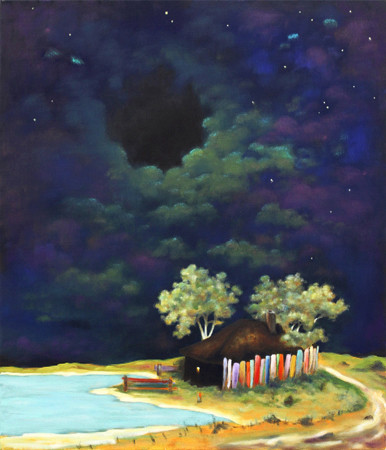Uwe Henneken
21 Jan - 10 Mar 2012
UWE HENNEKEN
Wahrnehmungen im Dunklen
21 January - 10 March, 2012
The new work by Uwe Henneken carries us off to a phenomenology of the gaze and a phenomenology of the night. As experiences of darkness they give a premonition of transience, seclusion and secrecy, and as alethia of love, faith and hope. They rouse our elementary emotions and touch us deeply because they disallow a reserved contemplation: The picture that we look at looks back at us.
Whether the countenance of the heavens or the divine gaze: As an opened or closed eye it rules over existence and nothingness. The importance of the constituent eye - the creative and the watchful glance stretches through the entire history of mankind. Theologically justifed, phenomenologically discussed and literarily testifed, Henneken now situates the gaze in an artistic and philosophical discourse.
Like an assault on the eyes the colouring if his work strikes us: impetuous, ecstatic and explosive. Like a pyrotechnician of nature Henneken presents us fames instead of colours: extravagant and tumultuous, idealizing and supernatural. Thus Henneken exponentiates the voice of nature into a feeling, the landscape into a soul landscape.
On an atmospheric level, it does not surprise that in the course of this picture cycle Henneken happened upon Heidegger ́s Der Feldweg. "Whenever the riddles pressed upon each other and no way out was in sight, the feldpath helped“1. As “wanderings where all shores are left behind,” as yearning and searching, Henneken ́s paintings also remind us of alienation and desolation. In his poetry of rurality, referring to Romantic natural philosophy, he addresses the search for the vertical sublime long lost to us. Thus the artist becomes a priest, the art proclamation.
Under the celestial vault and at the garden gate Henneken ́s Chinese whispers invites our gaze to feast on a symbiosis of darkness and light. At "the intersection of light and darkness the mortal and divine eye meet and and merge”2 Thus isolation transcends itself, turning into congress, likewise desertion into truthfulness, bewilderment into serenity: The picture that we are looking at is looking back at us.
Susanne Dudda
1 Heidegger: Der Feldweg
2Jacob Böhme: Theosophische Werke
Wahrnehmungen im Dunklen
21 January - 10 March, 2012
The new work by Uwe Henneken carries us off to a phenomenology of the gaze and a phenomenology of the night. As experiences of darkness they give a premonition of transience, seclusion and secrecy, and as alethia of love, faith and hope. They rouse our elementary emotions and touch us deeply because they disallow a reserved contemplation: The picture that we look at looks back at us.
Whether the countenance of the heavens or the divine gaze: As an opened or closed eye it rules over existence and nothingness. The importance of the constituent eye - the creative and the watchful glance stretches through the entire history of mankind. Theologically justifed, phenomenologically discussed and literarily testifed, Henneken now situates the gaze in an artistic and philosophical discourse.
Like an assault on the eyes the colouring if his work strikes us: impetuous, ecstatic and explosive. Like a pyrotechnician of nature Henneken presents us fames instead of colours: extravagant and tumultuous, idealizing and supernatural. Thus Henneken exponentiates the voice of nature into a feeling, the landscape into a soul landscape.
On an atmospheric level, it does not surprise that in the course of this picture cycle Henneken happened upon Heidegger ́s Der Feldweg. "Whenever the riddles pressed upon each other and no way out was in sight, the feldpath helped“1. As “wanderings where all shores are left behind,” as yearning and searching, Henneken ́s paintings also remind us of alienation and desolation. In his poetry of rurality, referring to Romantic natural philosophy, he addresses the search for the vertical sublime long lost to us. Thus the artist becomes a priest, the art proclamation.
Under the celestial vault and at the garden gate Henneken ́s Chinese whispers invites our gaze to feast on a symbiosis of darkness and light. At "the intersection of light and darkness the mortal and divine eye meet and and merge”2 Thus isolation transcends itself, turning into congress, likewise desertion into truthfulness, bewilderment into serenity: The picture that we are looking at is looking back at us.
Susanne Dudda
1 Heidegger: Der Feldweg
2Jacob Böhme: Theosophische Werke

